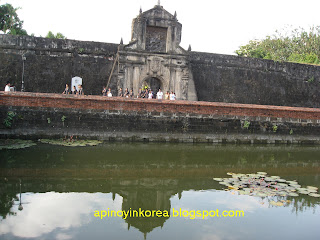It was built in 1571 by the Spaniards. A city within walls, intra-muros, it is the oldest district in Manila. It expanded and flourished with houses, imposing churches, offices and schools during the Spanish era, destroyed by the Japanese army and American bombs during World War II, restored by Imelda Marcos in the 1980s, and now enjoyed and visited by local and international tourists (like me) all year round.
And on this quiet afternoon, I roam Intramuros, imagining it was still the Spanish period when only people of Spanish descent were allowed to live within the walls, which means I may be literally dragged out of Intramuros by the guardia civil (civil guards) by nightfall. Ha-ha-ha! Or perhaps, if I could trick them with my Spanish name and my almost-forgotten Español (courtesy of Instituto Cervantes), I may be allowed to stay for the night!
And as I now walk around Fort Santiago, where Jose Rizal spent his last days, I trace his final steps towards his execution at Bagumbayan (now Rizal Park), on the morning of December 30, 1896, which brought delight and relief to the corrupt Spanish friars whom he pissed with his writings. And around the Fort, I see these small gardens, where Spanish ladies, peninsulares and mestizas, probably, enjoy late afternoon walks with their parasols and the latest society gossip. Ha-ha-ha!


And at that time, the Roman Catholic church was more influential and powerful than the Spanish governor. With these friars shouting their sermons from the pulpits every Sunday, they were revered and feared, as they successfully duped everyone that whoever does not follow what they preach is surely going to infierno, a Spanish word for ‘hell’, an idea which didn’t exist among the natives before the Spaniards came. (Thanks, Carlos, for this info!). That’s why these corrupt friars got away with almost anything. Classic fear mongering, I’d say.
And speaking of churches, the Manila Cathedral and the San Agustin Church in Intramuros are perhaps the most popular churches for weddings. A couple would need to reserve a year before their wedding date just to make sure they have a slot! Well, keeping the reservation for a year is easy; but I wonder if one of them changes his or her mind? Can he or she just get married to a new partner using the same reservation? Ha-ha-ha!
So, on this cool afternoon in Intramuros, I re-discover a part of Manila’s rich Spanish history riding a calesa, a horse-drawn carriage, meandering around the calles (streets) once roamed by Miguel Lopez de Legaspi, the first Spanish governor-general, who perhaps suggested to his big boss, King Philip II of Spain (after whom the Philippines was named), to build the settlement where it is now, surrounded by high walls and moats which protected it from angry natives as well as from Chinese, Japanese, British and Dutch raiders over the centuries.
I think Intramuros is best enjoyed during day time, when one can explore the place, the architecture, the atmosphere, and the shops while they're open. I don't recommend that one should roam the place at night, lest you want to encounter Spanish-speaking ghosts and guardia civil who will drag you out of the place shouting, Fuera de aqui! I'm talking about other human forms with not-so-good intentions. (You know what I mean).
This place is part of my history, a part of my being Filipino.
Intramuros.


















Intramuros is one of the places you have to visit when in Manila.
ReplyDelete